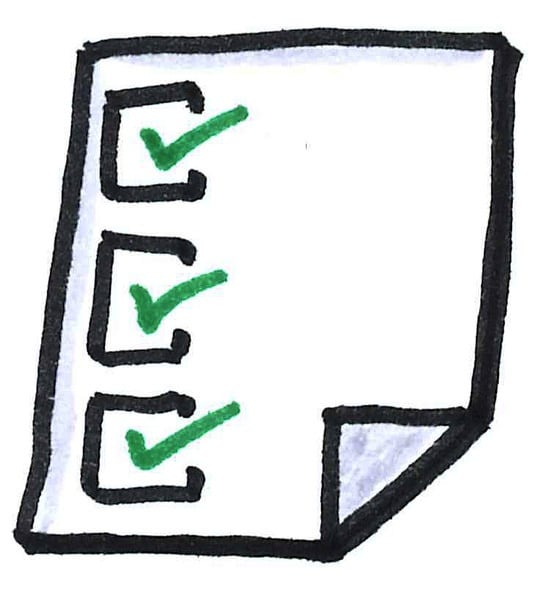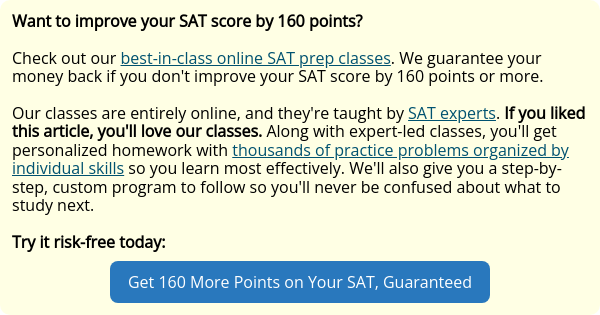
Note: The current version of the SAT no longer includes this type of question. For up-to-date SAT writing tips, check out our top guide here.
Identifying Sentence Errors (ISE) questions, which ask you to pick the error in a sentence out of four underlined sections, seem like they should be the easiest part of the SAT Writing section. After all, you only have to find the error, you don't have to fix it. The test writers, however, are extremely adept at camouflaging the mistake in each sentence—if you don't know what to look for, you can easily find yourself assuming there's no error in as many as half of the sentences.
As such, it's vital that you take a systematic approach to the Identifying Sentence Errors questions. If you count on spotting the error by simply glancing over the sentence or by looking for sections that "sound" weird, you'll miss a lot of questions.
In this post, I'm going to detail the most effective approach to these questions and the common errors you need to look for:
- Step-by-step Identifying Sentence Errors strategy
- Full breakdown of errors to check for
- Walkthrough of real ACT questions
- Summary of key Identifying Sentence Errors tips
General Strategy for ISE Questions
As I mentioned above, you absolutely must have a standardized approach to these questions. Following the three steps below will help you efficiently and reliably determine the answer to ISE questions.
#1: Read the Sentence All the Way Through
The first step to answering an ISE question is always to read the entire sentence—even if you think the error is choice A make sure to read all the way to the end. This approach will help prevent you from falling into traps.
Once you've read through the whole sentence, the error may jump out at you, especially on the earlier, easier questions. Before marking anything down, however, make sure you can articulate why the underlined word or phrase is wrong. Many answers may sound odd without being incorrect. It can also help to double check the other choices to ensure that they're all correct.
If you don't find the error, then move onto step 2!
#2: Check Each Underlined Portion
If you don't find a verifiable error the first time through, then you need to check each underlined section individually. Look at each answer and consider what the possible errors are. For example, if you're looking at underlined verb, you'll want to check if there's an issue with tense or agreement.
As you may have surmised, this step requires a solid knowledge of what concepts these questions actually test. I've created a checklist of errors to look for below, and you can take look at a full breakdown of what the SAT Writing actually tests.
Make sure to eliminate the answer that don't have an error.
#3: Confirm Why the Word You Picked is Wrong
It's not enough to pick an answer because it sounds weird or because it's not the word you would use. In order to be the answer, it has to be wrong according to the rules of SAT Writing. (The one semi-exception to this rule is idiom questions, which revolve around common usage rules.)
As such, you need to be able to explain what error the answer you picked contains. If you can't do so, it's probably not the right choice.

What Errors to Look for in Each Section of the Sentence
As I noted in step 2 of the general strategy, it's vital that you know what errors to check for. To help you think through the best way to look for these errors, I've created a full breakdown of the questions you'll want to ask yourself by what type of word is underlined.
This list is very long and probably seems overwhelming, but don't panic! You don't need to memorize the whole thing—instead it's meant as study aid.
First, make sure you're familiar with all the concepts on the list: if anything looks unfamiliar, just click the link.
Then, use this printable version to work through a few ISE sections, to help you get the hang of what errors to look for. When you first try this, it will probably take a really long time. With practice, you'll get much faster though.
Finally, keep the list handy for when you review your answers—use the list to go back through the questions and find the error you missed.
If nothing else, keep in mind these two key points:
- Check each underlined section independently
- Start with verbs and pronouns
Full Error Checklist
This checklist outlines the questions you need to ask about each part of speech or common category of word. I've also marked when a specific issue is especially rare (though these topics do still appear).
The word types are arranged in the order you should check them, though not every question will be relevant in a given sentence.
Keep in mind that some underlined sections may contain more than one type of word: the most common such pairs are pronoun/verb, adverb/adjective, and verb/pronoun combos. When you see these, just check each part.
#1: Verbs
- Is the verb in the correct form and tense?
- Does it agree with the subject?
#2: Pronouns
- Does the pronoun agree with the noun it's replacing?
- Is it in the correct case?
#3: Gerunds (-ing verbs)
- Is the gerund replacing a main verb and creating a sentence fragment?
- Is it part of a list that isn't parallel?
- Has it been incorrectly switched with an infintive?
#4: Prepositions
- Is the preposition idiomatically correct?
- Does it incorrectly complete a word pair?
#5: Adjectives and Adverbs
- Is the modifier of the correct type?
- Are -er and -est used appropriately? (Rare)
#6: Conjunctions
- Is the conjunction creating a sentence fragment?
- Does it logically connect ideas?
#7: Nouns
- Is the noun part of a faulty comparison?
- Is the sentence consistent in its use of plural and singular nouns? (Rare)
#8: Relative pronouns (who, which, that, etc.)
- Is the correct pronoun used for the context?
- Does the pronoun have a clear noun antecedent?
Other issues to watch out for
- "Any" underlined often indicates an illogical comparison
- The presence of comparison words like "than," "like," and "as" also tends to indicate illogical comparisons
- A sentence with a list often has a parallelism issue
- Make sure to watch for redundancy: the use of different two words
Concepts that Won't Be Tested on the Identifying Sentence Errors
There are a number of grammar concepts that students are often concerned or uncertain about that aren't actually tested by the ISE questions. Let's go over these, so that you can have fewer things to worry about as you prepare!
Writing style
One of the most challenging aspects of the ISE questions is that the sentences are often phrased in unusual ways that sounds like they could be wrong but usually aren't. Once again, remember that an choice is only correct if you can articulate the error it includes.
I've collected some of the common words and phrases that often trip students up but are perfectly acceptable below:
- a means of
- long since
- alike
- that, whether, and what + a noun (e.g. "That book was boring" or "Whether he likes it or not isn't the question."
Who vs. whom
Although many students are concerned about the difference between "who" and "whom," the SAT doesn't test that concept: you will never see "who" where you need "whom" or vice versa. Instead of worrying about swapping one for the other, focus on whether the pronoun is correctly referring to a person.
Pronoun order
Because of the way pronouns are taught in school, it's very common for students to be concerned about the order of pronouns connected by "and" or "or" (e.g. "me and him" vs. "him and me"), but the SAT doesn't test this concept. As long as the pronouns are in the correct case and agree with the words they're replacing, it doesn't matter what order they're in.
Reflexive Pronouns
Reflexive pronouns, the weird words like "herself" and "myself," tend to seem wrong, since many students don't know much about them. However, on SAT Writing, these words are usually used correctly. If you see one that's underlined, just make sure that the pronoun agrees with the noun it's replacing (e.g. the sentence doesn't use "himself" when talking about a woman).

Practice is the key to success on SAT Writing.
SAT Examples: Putting the Strategies into Practice
I've collected some Identifying Sentence Errors questions from real SATs. For each, I'll walk through the process one step at a time so you can get a sense of how best to approach these questions.
Because there are so many different concepts involved in answering these questions, I don't go into very much depth with any of them. If you're uncertain about the details of a specific topic, check out the links above.
Example 1

Step 1: Read the whole sentence
When going through this sentence, you might notice that it's actually a fragment. If so, the next step would be to determine which underlined part could be changed to fix that issue—that's the correct choice. (Hint: the sentence is currently missing a verb.)
However, let's assume you're not sure what the problem is and move onto step two.
Step 2: Check each answer choice
As I noted above, it's quickest to go through the answers by starting with the types of words most likely to have an error. There aren't any verbs or nouns underlined, so we'll look at B, "containing," which is a gerund, first.
The three main gerund issues are parallelism, idiomatic usage, and fragments. Let's go through them one at a time.
Is the gerund part of a list or comparison? No. Therefore, it can't have a parallelism error.
Would the sentence be clearer if you switched the gerund (-ing verb) for an infinitive (to + verb)? Let's check:
Formed by volcanic eruptions over the last five million years, the Hawaiian Islands to contain an incredibly wide variety of species—many found nowhere else on Earth.
That version doesn't seem obviously clearer, so it's probably not an idiom error.
Does the gerund create a fragment? Let's look at just the main clause of the sentence:
the Hawaiian Islands containing an incredibly wide variety of species
This is clearly a fragment. The gerund "containing" should be replaced with the conjugated verb "contain."
As such, B is the correct answer choice.
Step 3: Confirm what the error in your answer is
Choice B is the answer because it creates a fragment rather than a complete sentence.
Moreover, a quick look over the other answer choices confirms that none of them contain an error: A and D are idiomatically correct prepositions and C is an appropriately used adjective/adverb combo.
Example 2

Step 1: Read the whole sentence
Reading this sentence, I don't notice anything jump out, although D sounds kind of weird. Even if that answer seems tempting we can't pick it until we determine what the error is.
Step 2: Check each answer choice
First let's check B for errors, since it includes both a pronoun and verb. In general, if you see a pronoun/verb combo underlined, any errors will be with the pronoun (since the verb's conjugation is dependent on the subject pronoun), but make sure to confirm that the verb works. Let's go through the possible errors for choice B one at a time.
Is the pronoun in the correct case? Yes. "It" is acting as subject for the verb "makes," which is perfectly acceptable.
Does the pronoun agree with its antecedent? Yes. "It" is standing in for "the common cold," which is a singular non-gendered noun.
Is the verb correctly conjugated? Yes. "It" is a singular pronoun and "makes" is a singular verb.
Is the verb in the correct tense? Yes. It's in the present tense, which is consistent with the rest of the sentence and the fact that it is making a general true statement about the common cold.
We can now officially declare choice B error free and rule it out. Written out in detail, that process was a complicated, time-consuming one, but with practice you'll be able to do it much more quickly.
Let's move on to choice D, "you and me," which also includes pronouns. This section sounds a little weird, but remember that pronoun order doesn't matter—we only need to check agreement and case, like we did above.
Do the pronouns agree with their antecedents? There's no agreement issue, since the pronouns are referring to the person who is saying the sentence and the person he or she is peaking to (even though both of them are abstract).
Are the pronouns in the correct case? This question is a bit trickier. It would sound just fine to replace "me" with "I"—"it makes no distinction between you and I"—but "between" is a preposition, so the object case "me" is correct.
Although D sounds odd, it doesn't contain an error. We can eliminate it and move onto C, which includes a noun and preposition. We'll check the preposition first since it's more likely to include an error.
Is the preposition idiomatically correct? Yes. "Distinction between" is a common expression.
Does it incorrectly complete a word pair? No. "Between" is correctly followed by two prepositions connected by "and."
Is the noun part of a faulty comparison? No. "Distinction" isn't being compared to anything.
Is the sentence consistent in its use of plural and singular nouns? Yes. There's no issue with agreement.
Since we didn't find any issues with C, we'll move onto checking the last answer, A, "one of our most."
Given the many different types of words in this phrase, it doesn't make sense to check them all individually (the pronoun, for example, is clearly correct), so we'll just consider some of the bigger potential issues.
Is the phrase idiomatically correct? Yes. "One of our most indiscriminate diseases" is a clear and acceptable phrase.
Is the superlative/comparative correct? Yes. The common cold is being compared to all of the other diseases, so "most" is the correct word choice.
We can conclude that there is no error in A, so we've ruled out all the choices, leaving only E, "no error."
Step 3: Confirm what the error in your answer is
This sentence doesn't have an error, so the correct answer is E.
 Image: Allan Foster/Flickr
Image: Allan Foster/Flickr
Example 3

Step 1: Read the whole sentence
The first time through, this sentence probably seems fine. Ideally, you would notice the "any" in choice D, since that word is often a clue for an illogical comparison, but it's perfectly fine if you don't.
Step 2: Check each answer choice
We'll start with A, which is a verb.
Is the verb correctly conjugated? Yes. The subject "builders" is plural and "construct" is a plural verb.
Is the verb in the correct tense? Yes. The present tense is consistent throughout the sentence.
Next let's move on to the preposition/noun combo in choice B.
Is the preposition idiomatically correct? Yes. "Houses of stone" is a completely acceptable construction.
Does it incorrectly complete a word pair? "Of" isn't part of a pair here, so we can just skip this one and go straight to the noun.
Is the noun part of a faulty comparison? No. "Stone" isn't being compared to anything.
Is the sentence consistent in its use of plural and singular nouns? No other noun in the sentence refers to the same thing, so there's no issue with agreement.
There's no error in choice B, so we can rule it out and move onto choice C, which is the adverb "still."
Is the modifier of the correct type? "Still" is describing when the builders use the hammer, so it's correct as an adverb.
Are -er and -est used appropriately? There's no superlative or comparison used, so we can skip this question.
Finally, let's check choice D. "Tool" is a noun and "any" often indicates a comparison error so let's start by checking for that.
Is the noun part of a faulty comparison? The underlined phrase comes immediately after "than," which indicates a comparison. We need to determine what "any tool" is being compared to: it's "the hammer."
That comparison seem fine, but it actually includes an error. A hammer is a tool, so it must be compared with any other tool, rather than just "any tool." D is the answer.
Step 3: Confirm what the error in your answer is
Choice D is the answer because it creates an illogical comparison. We've also definitely ruled out the other choices (except no error).
Example 4

Step 1: Read the whole sentence
It's possible to spot the error in this sentence right away, but most students don't. Let's go straight to step 2.
Step 2: Check each answer choice
Once again we start with the verbs, which are in choices A and C. When there are two portions that seem equally likely to contain an error, I generally check them in order. Let's look at A, "are truly," first.
Is the verb in the correct tense? Yes. The present tense is used consistently throughout the passage.
Is the verb conjugated correctly? To determine whether the subject and verb agree, we need to figure out what the subject is. It's tempting to assume that it's "goby fish and striped shrimp" but the compound noun is actually part of the prepositional phrase "between goby fish and striped shrimp." (Besides, fish can't be symbiotic.)
Instead, the correct subject is "the relationship." This noun is singular, so the plural verb "are" doesn't agree. A has an error.
Step 3: Confirm what the error in your answer is
Choice A is the answer because the verb doesn't agree with its subject.
A quick review of the other three choices shows that there are no errors in the other options: they sound slightly odd, but the verb is conjugated correctly and the prepositions make sense.
 Image: Anne Worner/Flickr
Image: Anne Worner/Flickr
Round-Up of Strategies and Tips for ISE Questions
Now that we've gone through the best ISE approach in detail and put it into practice on some examples, let's review some of the main points that you'll want to keep in mind for your SAT study.
As complicated as the process may seem, it will get much easier with practice. But if you're really struggling, even just keeping a few of the simple rules in mind will boost your score.
Key Identifying Sentence Errors Strategies
- Always read the entire sentence
- When looking for the error, examine each choice individually
- Check verbs and pronouns first, since they're the most likely to include errors
- When an answer choice contains more than one type of word, check both
- Don't be afraid to pick E, "no error," if you've ruled out all the other choices
- Always make sure you can explain what error ;the answer contains
- Even if you think you know the answer, quickly check the other choices to confirm
Helpful Identifying Sentence Errors Tips
- Watch for comparisons and lists as you read the sentence; both often create errors when they appear
- "Any" often indicates a faulty comparison
- Longer phrases are less likely to contain an error
What's Next?
Make sure you know how to approach the other types of SAT Writing questions—Improving Sentences and Improving Paragraphs—as well.
Don't forget the essay! Here are some tips for boosting your score, a step-by-step guide, and strategies for getting a perfect 12.
Finally, check out some key big-picture strategies, like these 4 secrets to acing SAT Writing and these 11 SAT Writing tips from a perfect scorer.











